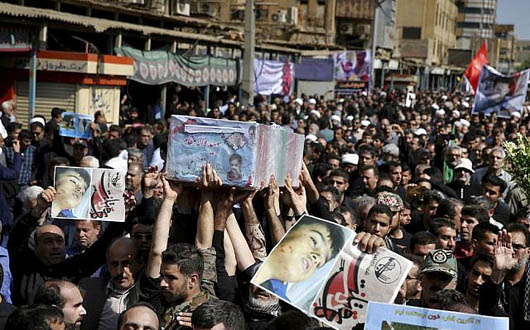TEHRAN, Sept 25, 2018 (BSS/AFP) – Iran on Tuesday identified the
perpetrators of a deadly attack on a military parade as “jihadist
separatists”, announcing a series of arrests and appearing to tie the Islamic
State group to the bloodshed.
The intelligence ministry published photos of the five men it said carried
out the assault Saturday in the southwestern city of Ahvaz that killed 24
people including a four-year-old child and other civilians.
“The five members of a terrorist squad affiliated to jihadist separatist
groups supported by Arab reactionary countries were identified,” the ministry
said in a statement.
“The terrorists’ hideout was found and 22 people involved (in the attack)
were arrested,” it said, adding that explosives were seized along with
military and communications equipment.
The attack targeted a parade in Khuzestan province commemorating the 1980-
1988 Iran-Iraq war.
The border region, which has a large ethnic Arab community, was a major
battleground of the conflict and saw ethnic unrest in 2005 and 2011.
Iranian officials initially blamed Arab separatists, who they claimed were
behind previous unrest, for the latest attack, saying they were backed by
Gulf Arab allies of the United States.
This version was bolstered when a movement called “Ahwaz National
Resistance”, an Arab separatist group, claimed responsibility shortly after
the assault.
But the Islamic State group (IS) was also quick to claim responsibility and
later posted a video of men it said were the attackers.
Iran’s supreme leader, Ayatollah Ali Khamenei, on Monday linked the
attackers to Iraq and Syria, where IS once had major strongholds.
“This cowardly act was the work of those very individuals who are rescued
by the Americans whenever they are in trouble in Iraq and Syria and who are
funded by the Saudis and the (United) Arab Emirates,” Khamenei was quoted as
saying by his official website.
– Saudi, UAE deny –
Iranian authorities have accused the United States, Israel, Saudi Arabia
and United Arab Emirates (UAE) of being behind the Ahvaz attack.
Both Riyadh and Abu Dhabi denied any involvement.
Saudi Arabia “completely rejects the deplorable false accusations by
Iranian officials regarding the kingdom’s support for the incidents that
occurred in Iran,” a Saudi foreign ministry official said Tuesday.
The UAE’s minister of state for foreign affairs, Anwar Gargash, has also
dismissed Iran’s accusation as “baseless”.
“This official campaign launched in Iran against the UAE is regrettable and
has escalated since the Ahvaz attack,” Gargash tweeted earlier this week.
The photographs of the alleged attackers released by the authorities
Tuesday showed the bodies of four men named as Ayyad Mansouri, Fouad
Mansouri, Ahmad Mansouri and Javad Saari.
The picture published by the intelligence ministry of an alleged fifth
member of the group, Hassan Darvishi, was a screenshot taken from the video
put out by IS.
According to local media two of the Mansouris are brothers and the third is
their cousin.
Abdullah Ganji, the managing director of the ultra-conservative Javan
daily, wrote on Twitter that a Mansouri brother “was killed in a suicide
bombing in Syria”.
There has been no known presence of Iranian Arab separatist groups in
Syria.
Ganji also wrote in an article that the nature of the attack in Ahvaz, in
which the assailants died, far more resembled IS than the “bombing or hit and
run operations” typical of Arab separatist groups.
“To kill until you are killed, without trying to leave the scene is the
method of (IS),” he said, pointing to parallels with a high-profile attack in
Iran last year.
On June 7, 2017 in Tehran, 17 people were killed and dozens wounded in
simultaneous attacks on the parliament and on the tomb of revolutionary
leader Ayatollah Ruhollah Khomeini — the first inside Iran claimed by IS.



